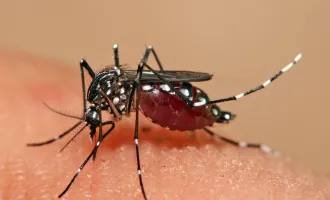
This Date in UCSF History: Mystery Surrounds Radiation Exposure Readings
[Originally published on October 15, 1987.] Synapse has learned that sometime last July three UCSF radioactive waste disposal workers’ radiation monitoring badges indicated exposures up to 1,000 times higher than expected — readings that are unprecedented for this campus.
Art Reich, an industrial hygienist with the campus Environmental Health and Safety (EHS) office, confirmed that the workers’ radiation monitoring badges indicated exposures that are unprecedented for this campus.
Reich said he was notified of the exposures on Sept. 15 by Radiation Detection Co., a Sunnyvale company which evaluates all UCSF film badges.
The badges of the three technicians indicated exposures of 2,650, 2,450 and 1,550 millirems respectively. “Rems” are a unit of measurement for radiation exposure.
“Normally, [die workers] wouldn’t have anything higher than 25 millirems,” Reich told Synapse in an interview on Oct. 12.
“Your legal standards are 1,250 millirems for a three-month quarter.” Reich says he phoned the State Department of Health Services (DHS) as soon as he learned of the high exposures.
DHS officials told Synapse that they have no record of a call from UCSF until Oct. 13.
They added, however, that UCSF’s only legal obligation is to file a written report within 30 days. J. Leroy Balzer, director of campus EHS, said a report would be completed by Oct. 16.
Radiation Detection Co. health physicist Beverly Paustenbach declined to comment on the UCSF matter.
She did say, however, that her company usually reads the badges in five to ten days. Balzer said he is unsure why UCSF was not notified about the high July readings for six weeks. He added that he intends to take the matter up with the company.
The circumstances of the incident have left UCSF officials uncertain about whether the workers themselves—or merely their badges — were actually overexposed.
“It’s curious,” Reich said. “Our badge company tells us that these badges were obviously exposed outside the filter holders.”
The monitoring badges worn by all campus employees who work around radioactive substances operate by the exposure of a piece of radiation-sensitive film.
The portions of the film that are blocked by the badge holder should not register any radiation exposure.
But in the three current cases, according to Reich, the entire film was exposed. EHS has concluded that the film had to be exposed separately from the holder. How that could happen remains a mystery.
“It’s extremely unlikely that they could get near anything that could give off this kind of dose,” Reich said. “We have notion of this on the basis of our normal operations.”
Each worker carries a Geiger counter that indicates if a package for disposal exceeds a radiation level of 5 millirems per hour. “Hot” waste — with higher radiation levels — is not moved until special disposal procedures can be used.
Because the technicians spend little time working together, the incident seems even more confusing, Reich added. EHS would not reveal the names of the workers affected, but according to Reich they say their job routines and badge handling procedures in July were completely ordinary.
When they went home at night, Reich said, the workers locked up their badges. And for August, badge readings returned to normal, DHS official Gerard Wong said that investigations of such unusually high radiation levels often uncover errors in badge handling — not actual exposures — as the cause.
But if the mystery remains unsolved, he added, the state assumes that the exposures did occur. When asked about the possibility that the badges may have been tampered with, Balzer said,
“Someone could have deliberately exposed them. ‘Sabotage’ may be one of the words you could use.”
Balzer added that he has no idea why someone would want do such a thing. When the initial EHS report is completed, Balzer said, he will consider whether further investigation is warranted.
The workers have taken a blood test for genetic damage, conducted by Dr. Sheldon Wolff, director of the UCSF Laboratory of Radiobiology.
Wolff cautions, however, that that it cannot definitively prove or disprove exposure to hazardous levels of radiation.
The genetic test’s main goal, he and Balzer explained, is to “reassure” the workers, The incident comes at an awkward time for UCSF’s health and safety program. Last March the campus was cited by the DHS for 33 radiation safety violations.
The university is currently trying to hammer out an agreement with the state to resolve the citations.
Synapse reported August 27 that UCSF has offered a major expansion of radiation safety monitoring as part of an out-of-court settlement, Balzer believes the most recent incident is an unrelated case, that the campus is handling it in a proper fashion, and that it is unlikely to affect the negotiations.
The DHS’s radiological safety chief, Jack McGurk, declined to comment on the effect the incident may have until after he reads UCSF’s report.



